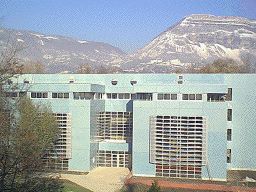
 2000
2000
Tuesday, 12th September 2000 |
||
| 9:00 am
- 12:30 pm |
Room | Room |
| Tutorial 1
Model Checking for Software Willem Visser and Charles Pecheur, RIACS/ NASA Ames |
Tutorial 2
The Role of Graph Transformation in Software Engineering and Requirements Engineering Michael Goedicke and Torsten Meyer, University of Essen Gabriele Taentzer, Technical University of Berlin |
|
| 12:30 pm
- 2:00 pm |
Lunch (On your own) | |
| 2:00 pm
- 5:30 pm |
Room | Room |
| Tutorial 3
Synchronous Programming of Reactive Systems: Principles, Languages, Compilers, Program Validation Nicolas Halbwachs, VERIMAG |
Tutorial 4
Component technologies - An Overview Wolfgang Emmerich, University College London/Zuehlke Engineering GmbH |
|
Description:
Model checking consists of the exhaustive exploration of the state
space of a dynamic system. Recently, there has been a trend towards
applying model checking to computer software. However, model checking
of software is a tough problem, due to the increased complexity of typical
software applications vs. hardware. To gain wider acceptance, model
checking must also be made more accessible to software developers.
This tutorial will give an overview of the main principles and tools for
model checking, and will give a survey of some recent progress in in model
checking applied to software. There will be two parts, devoted respectively
to explicit-state and symbolic techniques.
Explicit-state model checking explores each individual state of the
system individually. The SPIN tool from Bell Labs is one of the most
widely used in this category. We will address the explicit-state
analysis of actual source code written in popular programming languages
such as C, C++ and JAVA. It is clear that model checking by itself will
often not be enough to analyze programs due to the large state-spaces
of these programs. We will introduce some of the approaches currently
being used to model check programs with special emphasis on
the Java PathFinder (JPF) model checker and the role
of complementary analyses such as abstraction, static analysis and runtime
analysis within JPF.
Symbolic model checking uses efficient encodings of logic formulas,
such as binary decision diagrams (BDDs), to represent and explore whole
sets of system states in a single operation. For systems that can
be suitably represented, this allows the exploration of huge state spaces
of 10^50 states and more. We will present SMV, a well-known symbolic
model checker from Carnegie Mellon
University, with an input language for describing finite state systems
and their properties in the CTL temporal logic. We will then illustrate
the analysis of domain-specific modeling languages, such as those developed
at NASA for model-based autonomous space-craft controllers, by automated
translation of those languages to SMV.
Dr. Charles Pecheur
is a research scientist at NASA Ames Research Center. He is developing
and applying tools to verify model-based autonomy software, in particular
using the SMV symbolic model checker.
Dr. Willem Visser
is a research scientist at NASA Ames Research Center. He is currently
one of the developers of Java PathFinder 2, a native model checker for
Java programs.
Description:
Graphical representations are an obvious means to describe various
aspects of software systems. Many widely used methods in requirements engineering
and software design are based on graphs and graph changes. These graph
manipulation are systematically investigated in the area of graph transformation.
This formalism provides a variety of benefits important in the context
of visual development, e.g., the combination of intuitive usability with
the formal basis of visual specifications. A graph transformation step
is described in a rule-based manner by defining parts of the graph structure
before and after a transformation.
To handle several distributed parts of a graph where each part can be changed independently of others or in a synchronized way, distributed graph transformation has been developed. Here, graph transformation is employed twice: to describe the dynamic reconfiguration of the overall network of components, and to model evolving data and object structures within the components.
The main goal of this tutorial is to give an overview on the many application areas of graph transformation in the context of requirements engineering and software design and to impart a profound insight into the techniques of graph transformation based on algebra (category theory). In addition, tool support in form of a graph transformation machine implemented in Java is presented.
Two major case studies are discussed in order to demonstrate how the techniques presented in this tutorial work. The first case study refers to requirements engineering and tackles the multiple perspectives problem. We sketch how distributed graph transformation serves as a natural underlying formalism for the ViewPoints framework and how this approach helps to support multiple perspectives integration, Inter-ViewPoint negotiation and inconsistency management. The second case study refers to classical software engineering problems centered around architecture design. We discuss the possibility to represent semantic properties of components by the techniques presented in this tutorial with the final aim of realizing semantics-directed component negotiation and dynamic architecture (re-) configuration. Both case studies include a brief presentation of tool support developed for each case study on top of the general graph transformation tool.
Michael Goedicke is professor for computer science at the Department of Mathematics and Computer Science at the University of Essen, Germany. He studied Computer Science at the University of Dortmund and received there his Diploma Degree (Masters Degree) in Computer Science in 1980. He received his Ph.D. in 1985 and his Habilitation in 1993 from the Department of Computer Science of the University of Dortmund as well. His special field of interest is specification of software systems and software engineering. He is principal investigator in various national and international research projects and currently conducting research in formal methods and languages for requirements engineering.
Torsten Meyer is research assistant at the Department of Mathematics and Computer Science at the University of Essen, Germany. He studied Business Computing at the University of Essen and received there his Diploma Degree (Masters Degree) in 1995. He received his Ph.D. in 2000 from the Department of Computer Science of the University of Essen as well. His special fields of interest are software architecture, configurable distributed systems, requirements engineering and graph transformation.
Gabriele Taentzer
is working in the field of graph transformation since more than 10 years.
After studying computer science at the Technical University of Berlin she
received her Diploma degree in 1990 and her Ph.D. in 1996. She has extensive
teaching experience including a lecture on the European School on Graph
Transformation. She coorganized the last workshop on graph transformation
which took place as a satellite event of ETAPS 2000 in Berlin this year.
She is coeditor of two special issues on graph transformation appearing
in the journals MSCS and SCP. Her research addresses the application of
graph transformation to software engineering and the visual development
of distributed systems.
Gabriele Taentzer is working in the group of Prof. Hartmut Ehrig at
the Technical University of Berlin. Hartmut Ehrig is a leading authority
in the field of graph transformation.
Description:
Reactive systems are computer systems which maintain a continuous,
real-time, interaction with an external, possibly physical, environment.
Synchronous programming is an abstract point of view on reactive systems,
which considers such a system as a synchronous product of automata. A transition
of each automaton corresponds to an atomic, conceptually instantaneous,
reaction of the reactive component to events coming either from the environment
or from other synchronous components.
Based on this point of view, several programming languages have been proposed, mainly in France. In this tutorial, we will consider two of them: The imperative language Esterel, and the data-flow language Lustre. The basic principles of the languages will be first presented and illustrated. Then we will expain some common problems and techniques related to the semantics and compilation of synchronous languages. The addressed class of reactive systems being generally highly critical, program validation is an important issue. This is why we wil finally present available validation techniques and tools (formal verification, automatic testing).
Nicolas Halbwachs is "Research Director" at CNRS. His first work was on abstract interpretation of programs, with Patrick Cousot. In 1984, he obtained his "State Thesis", at "Institut National Polytechnique de Grenoble", under the supervision of Paul Caspi, on a formal model of real-time system behavior. Since then, he was one of the main designers of the synchronous data-flow language Lustre. He successively worked on the language design, compilation to software and hardware, and on formal verification and testing of synchronous programs. He is strongly involved in the industrial transfer of Lustre technology.
Description:
This tutorial will provide an overview of component technologies to
software engineering researchers and practitioners. We will review local
component technologies, such as Microsoft's Component Object Model and
Sun's Java Beans. We will then indicate distributed object technologies,
including Sun's Remote Method Invocation and the OMG's Common Object Request
Broker Architecture. We will then highlight how these two technologies
merged and let to distributed component models. We will discuss these by
comparing Microsoft's Distributed Component Model with Sun's Enterprise
Java Beans and the OMG's CORBA Component Model.
Dr. Wolfgang Emmerich is a Lecturer in Computer Science at University College London. He has authored numerous papers about distributed software engineering and a long standing interest in distributed object and component technologies. Wolfgang has recently published a textbook on "Engineering Distributed Objects" with John Wiley & Sons. He is also actively consulting in industry through his consultancy firm Zuehlke Engineering.